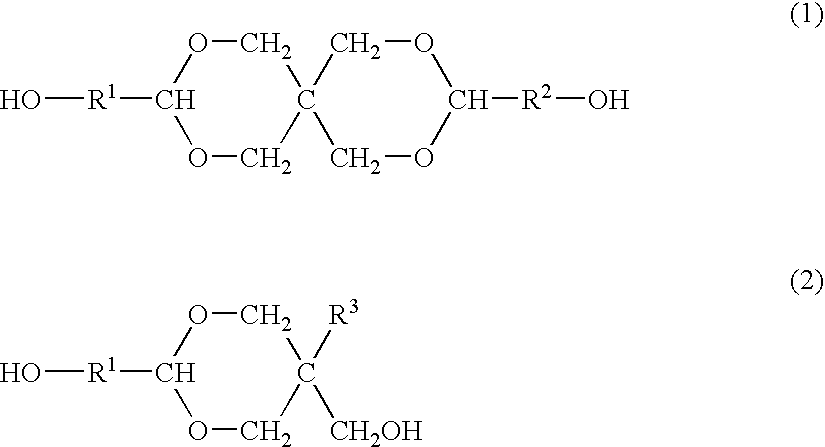Process for producing polyester resins
- Summary
- Abstract
- Description
- Claims
- Application Information
AI Technical Summary
Benefits of technology
Problems solved by technology
Method used
Image
Examples
examples 5-8
[0103]The respective esters (D1) obtained in Examples 1 to 4 were mixed with a diol having no cyclic acetal skeleton in an amount as shown in Table 2, and then depolymerized at 215° C. under ordinary pressure. After the reaction product became uniform, a predetermined amount of the diol having no cyclic acetal skeleton was distilled off at 215° C. under 13.3 kPa to obtain an ester (D2) (production method B).
[0104]The ester (D2) was subjected to the steps (1) and (2) in the same manner as in Example 1.
[0105]
TABLE 2Examples5678Ester (D1)produced inEx. 1Ex. 2Ex. 3Ex. 4average polymerization degree35702518b / a0.0300.0050.0100.020molar ratio1.151.051.201.30DepolymerizationEG added (mol)22.124.720.818.2molar ratio2.002.002.002.00Ester (D2)average polymerization degree10121010b / a0.0140.0020.0040.009molar ratio1.401.401.401.40Step (1)SPG (mol)1.314.36.5—DOG (mol)———2.6c / a0.050.550.250.10(b / a) × (c / a)0.00070.00110.00100.0009Water content (%)0.050.100.050.30Properties of polymersMn135001200014...
examples 9-10
[0106]The respective esters obtained in Examples 1 and 2 were mixed with 0.1 mol % of trimethyl orthoformate based on the dicarboxylic acid constitutional unit to obtain an ester (D1′).
[0107]The ester (D1′) was subjected to the steps (1) and (2) in the same manner as in Example 1.
examples 11-12
[0108]The respective esters (D1) obtained in Examples 1 and 2 were mixed with a diol having no cyclic acetal skeleton in an amount as shown in Table 3, and then depolymerized at 215° C. under ordinary pressure. After the reaction product became uniform, a predetermined amount of the diol having no cyclic acetal skeleton was distilled off at 215° C. under 13.3 kPa, and then 0.1 mol % of trimethyl orthoformate based on the dicarboxylic acid constitutional unit was added to obtain an ester (D2′).
[0109]The ester (D2′) was subjected to the steps (1) and (2) in the same manner as in Example 1.
[0110]
TABLE 3Examples9101112Ester (D1)produced inEx. 1Ex. 2Ex. 1Ex. 2average polymerization degree35703570b / a0.0300.0050.0300.005molar ratio1.151.051.151.05DepolymerizationEG added (mol)——22.124.7molar ratio——2.002.00Ester (D2)average polymerization degree——1012b / a——0.0140.002molar ratio——1.401.40Esters (D1′) and (D2′) after adding trimethyl orthoformateaverage polymerization degree35701012b / a0.0250....
PUM
| Property | Measurement | Unit |
|---|---|---|
| Temperature | aaaaa | aaaaa |
| Percent by mass | aaaaa | aaaaa |
| Substance count | aaaaa | aaaaa |
Abstract
Description
Claims
Application Information
 Login to View More
Login to View More - R&D
- Intellectual Property
- Life Sciences
- Materials
- Tech Scout
- Unparalleled Data Quality
- Higher Quality Content
- 60% Fewer Hallucinations
Browse by: Latest US Patents, China's latest patents, Technical Efficacy Thesaurus, Application Domain, Technology Topic, Popular Technical Reports.
© 2025 PatSnap. All rights reserved.Legal|Privacy policy|Modern Slavery Act Transparency Statement|Sitemap|About US| Contact US: help@patsnap.com



